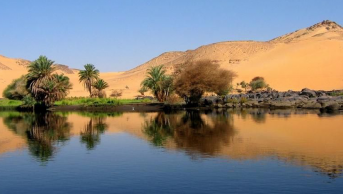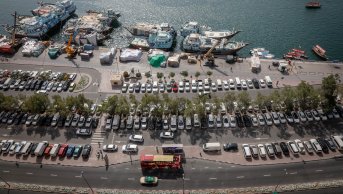Reconfiguring the Aquatic Divide in North East Africa: The Rise and Fall of the Great Man Made River

1953 was an annus mirabilis for Libya, when a double godsend was discovered beneath the seemingly infinite desert of the Great Sahara. The initial search was for oil, which proved to be successful. Significant oil fields were discovered. Along with this, huge quantities of freshwater reserves were alsodiscovered. These sources of water were very old fossil (i.e. non-replenishing) aquifers, some of which are close to 40 thousand years old. And for some estimates, the amount of these reserves can be up to 20 thousand cubic kilometers.
At first, the idea of Libyan leadership was to create agricultural towns at where these waters are found. It was soon understood, however, that the people in the coastal areas near the Mediterranean are hesitant to move to harsh geographies of south. Then, Gaddafi decided to ‘bring water to the people’, instead of ‘bringing people to the water’, and initiated the construction works in 1983.
The project hitherto swallowed some 20 billion dollars. Many countries are involved in different phases of construction, but the main input of the project, namely the concrete segments of the pipeline are produced inside Libya, at a factory close to Ajdabiya. Around 7 million cubicmeters of water is now being conveyed daily through a massive network of pipes extending some 4000 kilometers. It makes up more than three fifth of the total water used in the country.
The transboundary dimension of the Great Man Made River is also noteworthy. The Project is a game changer just like the Grand Ethiopian Renaissance Dam on the Blue Nile. Through its massive network of wells and pipelines, Libya established a clear advantage in using the transboundary waters of Nubian Sandstone Aquifer system, possibly at the expense of other basin countries, including Egypt, Chad and Sudan.
Some Libyan authorities claimed that the aquifer would be good for –at least- several thousand years. Muammar Gaddafi, the Libyan dictator once boasted that the Project will make Libya as green as its flag.In the end, the inflation of expectations triggered wasteful use of water. Now, as there are reports that some wells in the Egyptian side has already dried up, re-evaluations on the amounts of available water in the aquifer need to be made. According to some experts, the aquifer cannot survive into the 22nd century.
Population in the basin countries increased in an unabated fashion during the 20th and early 21st centuries, intensifying pressures on transboundary water resources in the region as a whole. The population of Libya, for instance, increased more than four times in the last fifty years. A similar trend is also observable for Chad. This country’s population increased around four times in the last half century. In Sudan, the second biggest country of the basin, the rate of increase is even higher: Sudan’s population increased around five times between 1960 and 2010. With ample water resources, Sudan was presented in 1960s (with 7.5 million inhabitants) as a potential breadbasket for the whole Middle East.In less than seven decades, Sudan’s population has now reached to 42.3 million, making it to struggle to grow food for its own people. When it comes to Egypt, the biggest country of the Nubian Aquifer Basin, had a population of 27 million in 1960. Now, the country feeds around 96 million people. Overall, since 1960,120 million people are added to the total population of the Nubian Aquifer Basin countries.
Instead of relying solely on this finite non-renewable source, soaring populations in the Nubian Sandstone Aquifer Basin necessitate more compound solutions, which can also be cheaper in the long run, taking into account of the ‘resource cost’ of consuming up a non-recharging fossil resource. In other words, the cost of the Great Man Made River is actually much more than the cost of the infrastructure built in the last quarter of the 20th century.
During NATO’s involvement in the conflict, the Project was seriously disrupted. Not only a number of pipes, but also the main plant at Brega which was producing pre-stressed concrete cylinder pipes were harmed. According to NATO, Brega plant was used to launch missiles by Gaddafi loyalists. For many others, NATO’s airstrikes directly targeted the success of the Great Man Made River Project, in order to cripple Libya and make it vulnerable to western intervention. While the project is so huge to become fully abandoned, it did become quite demanding, in war-torn Libya, to repair all the damage and attract new funding for the remaining phases of the Project. Thus, the post-Gaddafi part of the story of the Great Man Made River is still being written. But even more serious pressure for the Great Man Made River Project may originate from the population bombs of Sudan and Egypt in the upcoming decades. The current gloomy outlook for the Nile cooperation around the contentious Grand Ethiopian Renaissance Dam is likely to motivate these countries to seek for greater shares in the Nubian Bain.
To conclude, NATO Bombardment in July 2011, and continuing internal conflict in Libya certainly created a misery for all people in Libya. One of victims of this process is the water system of the country, particularly including the Great Man Made River. On the other hand, the current ill fate of the Project may create some time for all countries of the basin to come together to find sustainable as well as more equitable solutions for their unchecked increases of demand for water.







